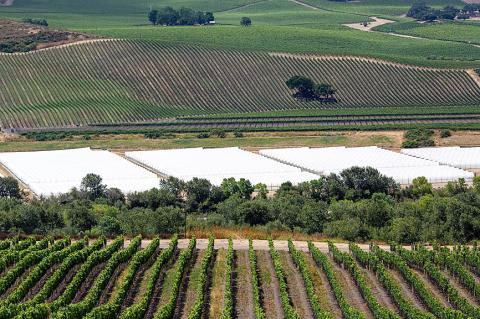A bitter war has erupted between pot growers and vintners in one of California’s famed wine regions where cannabis farms are proliferating, leading critics to denounce a “green rush” they fear could prove disastrous.
The battle, which began shaping up after California voters legalized recreational marijuana in November 2016, has pitted wine growers in Santa Barbara County and residents of the picturesque beach town of Carpinteria against a new neighbor they say literally stinks and threatens their livelihood and way of life.
“I think this is the single greatest threat to the wine industry that I have seen in my 25 years here,” said Stephen Janes, general manager at Pence Vineyards, located in the Santa Rita Hills.

Photo: AFP
At issue is the vast expansion of the cannabis market in the county in the last two years, thanks partly to loose licensing regulations at the local level that opened the door to a rush of growers keen to cash in on the lucrative crop.
Almost overnight, critics say, millions of flowering cannabis plants popped up in the Santa Ynez and Santa Maria valleys, a vast wine-growing area.
Further south in Carpinteria, greenhouses once used to grow flowers and located near residential areas have been repurposed to grow weed, much to the chagrin of some local residents irate over the pungent and pervasive odor that emanates from the plants.
“I have to wear a mask now when I go out to my garden, and my grandchildren won’t visit anymore because of the smell,” said Joan Esposito, who has lived in the town for 36 years.
In the Santa Rita Hills area, known for its Pinot Noir production and located about two hours north of Los Angeles, white plastic hoop houses for pot growing extend in places as far as the eye can see and sit near vineyards and avocado farms.
“It’s not like any farming neighbor we’ve ever had, and this is all happening very quickly,” said Kathy Joseph, owner of Fiddlehead Cellars and Fiddlestix Vineyard. “No one anticipated the visual impact, nobody in the region had ever experienced cannabis in this quantity.”
“In many ways, cannabis is ruling the roost right now,” she said.
Vintners, avocado growers and other farmers say they are having to adapt their farming practices — including by using organic pesticides often less effective than conventional ones — lest the newcomers sue them for inadvertently contaminating their high-value crop.
Wine growers add that they, in turn, fear that their grapes could be contaminated by particles from pot plants.
“This has turned into a living nightmare,” said Joseph, whose neighbor has filed a complaint against her over fears that the pesticides she uses on her vines might have contaminated his cannabis.
“I have committed over 40 years to making wine ... and as wine growers we operate under strict controls,” she added. “But this year, I am probably going to lose my crop of Chardonnay, worth US$50,000, because I had to switch to a pesticide that was not as effective for mildew.”
Members of the Santa Barbara County Board of Supervisors, which is responsible for setting policies on cannabis, acknowledged that the county should have anticipated the unintended consequences of pot farms on existing agriculture and residents in the region.
“I am very concerned about the impacts of outdoor cannabis operations concentrated in the Santa Ynez Valley and am working vigorously to protect existing vineyards and agricultural operations from the negative impacts of this new industry,” board member Joan Hartmann said.
She said the county had limited cannabis cultivation in the region to under 800 hectares and was exploring ways to defuse the escalating conflict.
Graham Farrar, chief executive of Glass House Farms in Carpinteria and president of the local Cannabis Association for Responsible Producers, said pot growers have gone out of their way to be good neighbors, installing odor control systems and injecting much-needed tax dollars into the community.
“The community supports cannabis and the average individual walking down the street either doesn’t care, supports cannabis in concept or the farmers specifically,” he said.
He also dismissed complaints about odor, saying that while there may still be an occasional whiff of the skunk-like smell, it was hardly overwhelming.
“I think that many of the people who talk about the odor don’t like it because it reminds them that there is cannabis growing there and they think cannabis is a moral failing and society would be better without it,” Farrar said.
However, his argument does not sit well with everyone.
“For an industry that has been here for 40-45 years ... and contributes US$1.8 billion to the local economy, to have another industry come in and cause us to change our ways, affect our grape growing, I don’t think is right or fair,” Janes said.
He said he and other vintners were not opposed to marijuana, but are pushing for stricter controls to preserve their livelihood and not have the smell of cannabis compete with the aroma of wine in tasting rooms.

BACKLASH: The National Party quit its decades-long partnership with the Liberal Party after their election loss to center-left Labor, which won a historic third term Australia’s National Party has split from its conservative coalition partner of more than 60 years, the Liberal Party, citing policy differences over renewable energy and after a resounding loss at a national election this month. “Its time to have a break,” Nationals leader David Littleproud told reporters yesterday. The split shows the pressure on Australia’s conservative parties after Prime Minister Anthony Albanese’s center-left Labor party won a historic second term in the May 3 election, powered by a voter backlash against US President Donald Trump’s policies. Under the long-standing partnership in state and federal politics, the Liberal and National coalition had shared power

CONTROVERSY: During the performance of Israel’s entrant Yuval Raphael’s song ‘New Day Will Rise,’ loud whistles were heard and two people tried to get on stage Austria’s JJ yesterday won the Eurovision Song Contest, with his operatic song Wasted Love triumphing at the world’s biggest live music television event. After votes from national juries around Europe and viewers from across the continent and beyond, JJ gave Austria its first victory since bearded drag performer Conchita Wurst’s 2014 triumph. After the nail-biting drama as the votes were revealed running into yesterday morning, Austria finished with 436 points, ahead of Israel — whose participation drew protests — on 357 and Estonia on 356. “Thank you to you, Europe, for making my dreams come true,” 24-year-old countertenor JJ, whose

A documentary whose main subject, 25-year-old photojournalist Fatima Hassouna, was killed in an Israeli airstrike in Gaza weeks before it premiered at Cannes stunned viewers into silence at the festival on Thursday. As the cinema lights came back on, filmmaker Sepideh Farsi held up an image of the young Palestinian woman killed with younger siblings on April 16, and encouraged the audience to stand up and clap to pay tribute. “To kill a child, to kill a photographer is unacceptable,” Farsi said. “There are still children to save. It must be done fast,” the exiled Iranian filmmaker added. With Israel

NO EXCUSES: Marcos said his administration was acting on voters’ demands, but an academic said the move was emotionally motivated after a poor midterm showing Philippine President Ferdinand Marcos Jr yesterday sought the resignation of all his Cabinet secretaries, in a move seen as an attempt to reset the political agenda and assert his authority over the second half of his single six-year term. The order came after the president’s allies failed to win a majority of Senate seats contested in the 12 polls on Monday last week, leaving Marcos facing a divided political and legislative landscape that could thwart his attempts to have an ally succeed him in 2028. “He’s talking to the people, trying to salvage whatever political capital he has left. I think it’s